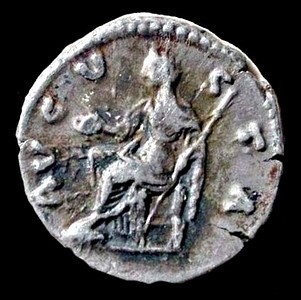Vesta |
Vesta |
For the Latins the ancient goddess Vesta personified earth and fire. Although she is equated with the Greek goddess Hestia, as a Roman divinity of the sacred fire of the hearth Vesta protected the family hearth in particular as well as every sacrificial fire. As protectress of Roman family life she was worshipped in every Roman household, while the fire of the Roman state was continually kept alight in the round temple of Vesta in the Roman forum. Her festival, the Vestalia, also commonly held as a bakers' holiday, was celebrated from June 7 each year. On Roman coins Vesta appears as a matron, either standing or seated, holding a patera and sceptre, sometimes a torch; a simpulum or the palladium. She is always veiled. A commemorative denarius of Faustina the Elder (on the right), struck under Antoninus Pius, depicts a seated Vesta, veiled, and holding a patera and short sceptre. |
 |